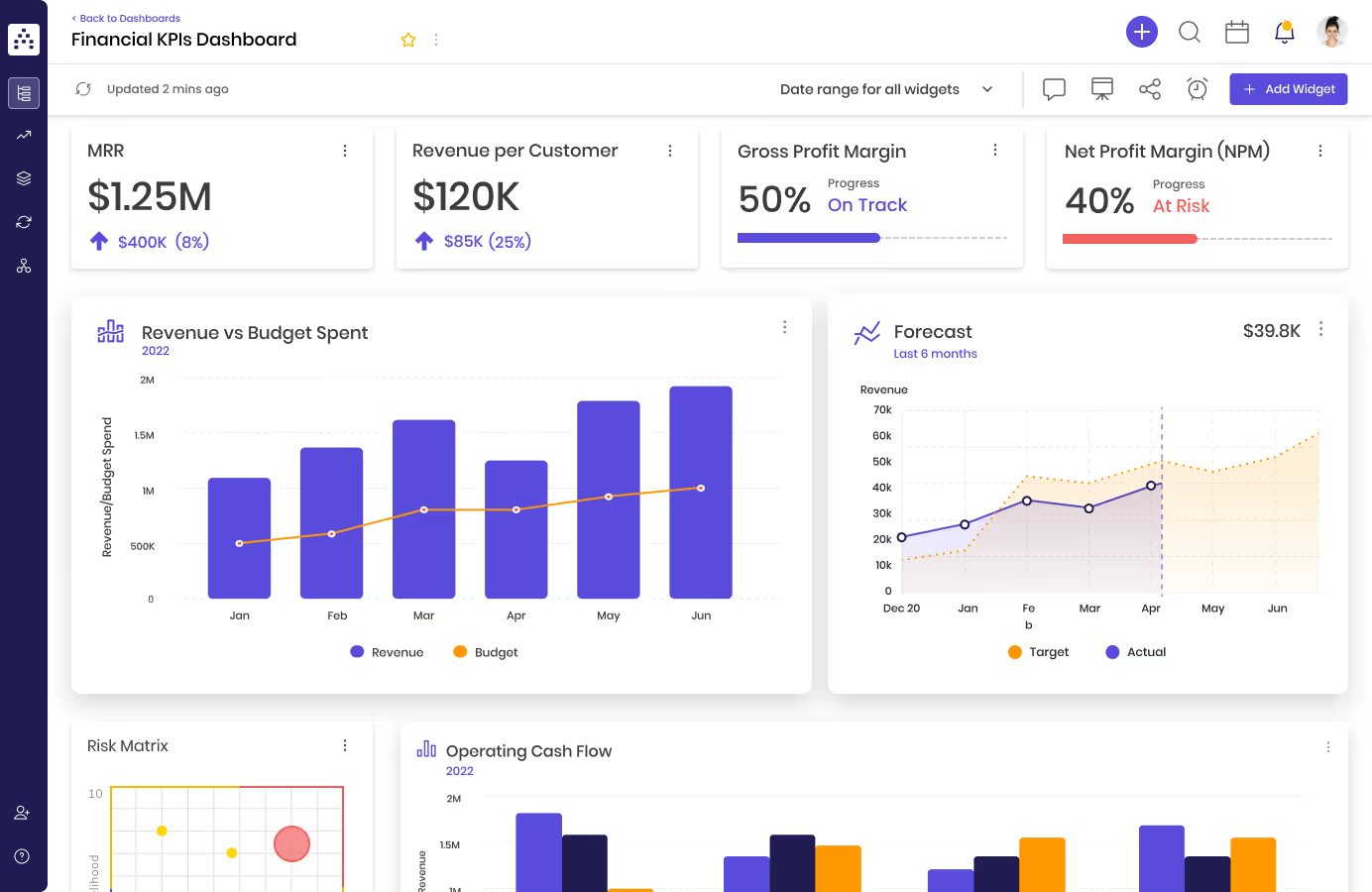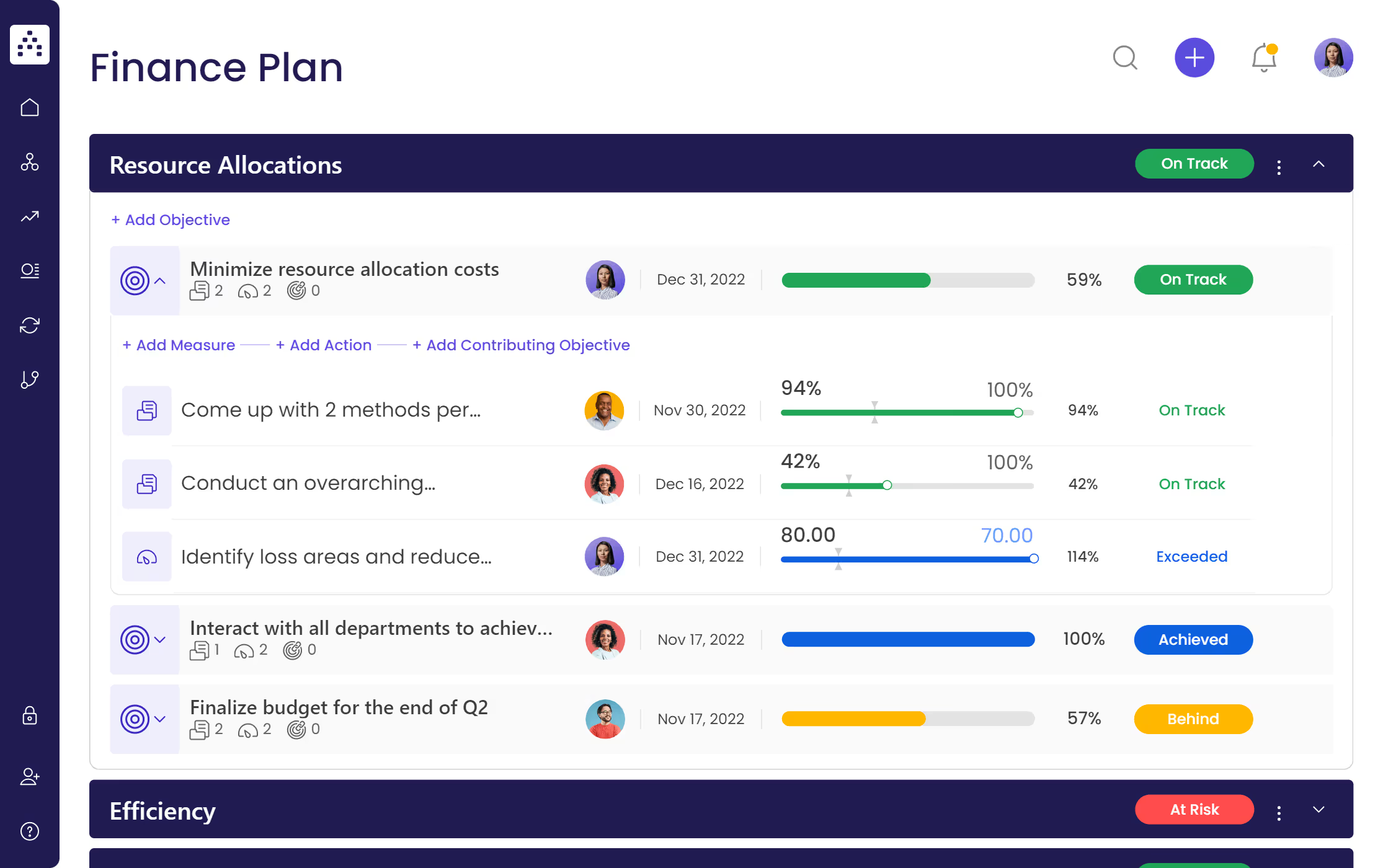What Is A Finance Strategy Plan?
A Finance Strategy Plan, also known as a Financial Strategy plan, plays a crucial role in the operations of any organization as it serves as a roadmap for effectively allocating and distributing financial resources to fulfill both short-term and long-term strategic objectives.
The primary purpose of a Finance Strategy Plan is to outline a structured approach for managing and optimizing financial resources within an organization. It involves formulating a comprehensive action plan that aligns financial decisions with the overall business goals and objectives. By doing so, the plan helps ensure that financial resources are utilized efficiently and effectively to support the organization's mission and drive sustainable growth.
What's Included In This Finance Strategy Template?
- 4x Financial Focus Areas
- 12x Financial Objectives
- 22x Financial Projects
- 26x Financial KPIs
Once you have set your template, you can also create up to two dashboards for real-time performance monitoring.
And yes - you get free access with no credit card required. ✅
Who Is This Finance Strategic Plan For?
A Finance Strategy can be developed by the finance department but can be used by all departments in an organization since they all need to effectively manage and allocate financial resources to meet their teams’ goals. The plan serves as a guide for CEOs, CFOs, managers, and entrepreneurs who seek to align financial decisions with the business strategy.
It is relevant to businesses of all sizes, including startups, established companies, nonprofit organizations, and government entities. The Finance Strategic Plan empowers stakeholders to make informed decisions, optimize resource allocation, mitigate risks, and drive sustainable financial growth in their respective domains.
How Is This Finance Strategy Template Relevant To Your Organization?
The Finance Strategy Template is highly relevant to your organization as it provides a structured framework for financial management, including forecasting, to effectively navigate your financial situation. By utilizing this template, your organization can develop robust financial forecasts that aid in budgeting, resource allocation, and decision-making.
The template helps you assess your current financial situation and identify areas for improvement. It guides you in developing strategies to optimize financial performance, mitigate risks, and seize opportunities. Implementing this template enhances your organization's financial management practices, allowing you to proactively plan, adapt, and achieve your strategic objectives.
1. Define clear examples of your focus areas
The first step to devising a Finance Strategy plan would be to have an understanding of the areas within your organization that your team and you want to focus on. These focus areas can be divided up per department, or per finance policy, you want to implement to attain your desired strategic goals.
Examples of strategic focus areas that could fall under a finance strategy plan could be: Profitability, Liquidity, Efficiency, Resource Allocations.
Cascade’s Finance Strategy Template comes pre-filled with the most common focus areas, but it’s 100% editable, so you can change them to match your organization’s needs.
2. Think about the objectives that could fall under that focus area
What strategic goals do your team and you want to have planned over the next 305 years? Are the goals short-term or long-term? Distinguishing and accordingly setting financial objectives will give your company a solid plan to help move it in the direction of long-term success.
Setting financial objectives will also make you aware of potential risks and how to mitigate or minimize the impact of said risks. Depending on your area of focus, these objectives can help you increase revenue, boost profit margins and facilitate making investment decisions.
Examples of some objectives for the focus area of “Profitability” could be: Close the Series A round, Improve the company's cash flow and margins, Seek to attain internal and external growth.
3. Set yourself measurable targets (KPIs) to tackle the objective
Financial KPIs (or metrics) are extremely crucial to providing you with measurable values that provide indicators of your company's financial performance, with regard to expenses, sales, profits, and cash flow, as a means of enabling an organization to optimize and achieve its business objectives and financial goals.
Some examples of KPIs for the objective “Improve the company's cash flow and margins” could be:
- Reduce accounts receivable
- Increase gross margins
- Increase operational margins
Remember it's crucial that all the KPIs you set have measurable goals tied to them.
4. Implement related projects to achieve the KPIs
Projects can be viewed as the actionable initiatives of your set goals; they are the jobs you undergo to achieve your end strategic objectives.
A few examples of projects that enhance “Profitability” within your organization could be:
- Contact and set up meetings with VCs
- Assist founders to focus on key drivers of their business
- Hire bookkeeping and admin team to handle invoices and payments and manage inventory
- Create a customer discount scheme to recognize early payments
- Generate an efficient Project Information Management and Streamline operations
5. Utilize Cascade tools to track and visualize performance
Whilst projects can be perceived as the actions that help your team and you to achieve your goals, widgets can assist in providing visual aids of the progress of your goals. Setting up widgets on Cascade's dashboards in the form of charts and graphs can help you to track your team's performance on a specific objective.

👉🏻Check Out Our Related Templates!
Our Template Library has thousands of ready-to-use templates to support you in creating your strategic plans.
Here are some other Financial Templates you may like:


